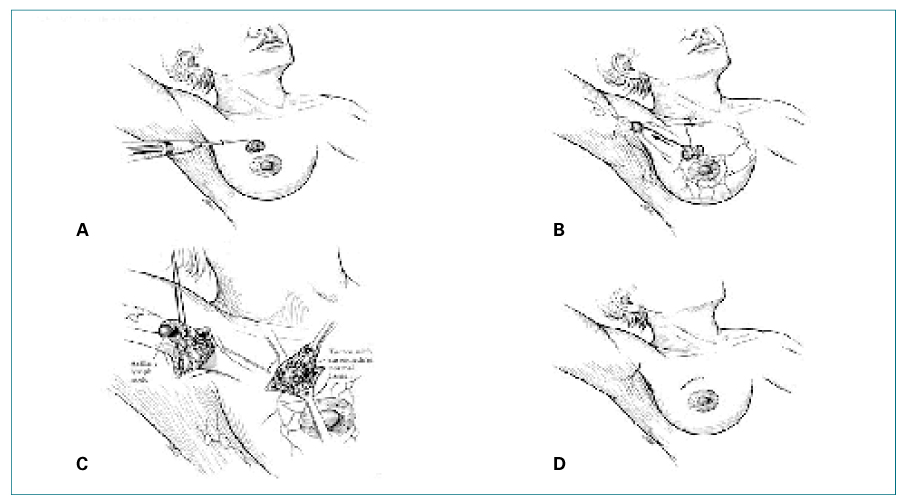J Korean Med Assoc.
2003 Jun;46(6):497-502. 10.5124/jkma.2003.46.6.497.
Surgical Treatment of Breast Cancer
- Affiliations
-
- 1Department of General Surgery, Samsung Medical Center, Sungkyunkwan University School of Medicine, Korea. jhyang@smc.samsung.co.kr
- KMID: 2183086
- DOI: http://doi.org/10.5124/jkma.2003.46.6.497
Abstract
- Breast cancer is the most common malignancy among women in Korea. Over the past decades, the surgical treament of the breast cancer evolved significantly, and the trend has been towards less conservative approaches. The introduction of percutaneous image-guided biopsy has allowed less invasive diagnosis of nonpalpable breast lesions. Breast conservative therapy has become accepted as an alternative to mastectomy for more patients with ductal carcinoma in situ and early stage invasive brest cancer. Another major advance in the surgical treatment of breast cancer has been the development of the sentinel node biopsy procedure. This is a way to determine if the axilla is negative for metastases without a complete axillary dissection and its physical and functional complications. Since many patients today are diagnosed with early stage breast cancer and negative axillary nodes, this technique offers substantial benefit to numerous women.
MeSH Terms
Figure
Reference
-
1. Meric F, Hunt KK. Hunt KK, Robb GL, Strom EA, Ueno NT, editors. Surgical options for breast cancer. Breast Cancer. 2001. New York: Springers;187–222.
Article2. Christian MC, McCabe MS, Korn EL, Abrams JS, Kaplan RS, Friedman MA. The National Cancer Institute audit of National Surgical Adjuvant Breast and Bowel Project Protocol B-06. N Engl J Med. 1995. 333:1469–1474.
Article3. Veronesi U, Saccozzi R, Del Vecchio M, Banfi A, Clemente C, Zucali R, et al. Comparing mastectomy with quadrantectomy, axillary dissection, and radiotherapy in patients with small cancers of the breast. N Engl J Med. 1981. 305:6–11.
Article4. Early Breast Cancer Trialists' Collaborative Group. Effects of radiotherapy and surgery in early breast cancer. N Engl J Med. 1995. 333:1444–1455.5. National Institute of Health. Treatment of early-stage breast cancer; National Institute of Health Consensus Development Conference Statement. 1990. Betheda, MD: US Public Health Service.6. Sakorafas GH. Breast cancer surgery. Acta Oncol. 2001. 40:5–18.7. Fisher B, Dignam J, Wolmark N, Mamounas E, Costantino J, Kavanah M, et al. Lumpectomy and radiation therapy for the treatment of intraductal breast cancer : findings from National Surgical Adjuvant Breast and Bowel Project B-17. J Clin Oncol. 1998. 16:441–452.
Article8. Singletary SE, McNeese MD, Hortobagyi GN. Feasibility of breast-conservation surgery after induction chemotherapy for locally advaned breast carcinoma. Cancer. 1992. 69:2849–2852.
Article9. Giuliano AE, Kirgan DM, Guenter JM, Morton DL. Lymphatic mapping and sentinel lymphadenectomy for breast cancer. Ann Surg. 1994. 220:391–401.
Article11. Schwartz GF, Giuliano AE, Veronesi U. Consensus Conference commitee. Proceedings of the consensus conference on the role of sentinel lymph node biopsy in carcinoma of the breast. Breast J. 2002. 8:124–138.12. Izzo F, Thomas R, Delrio P, Rinaldo M, Vallone P, Curley SA, et al. Radiofrequency ablation in patients with primary breast carcinoma: A pilot study in 26 patients. Cancer. 2001. 92:2036–2044.
Article
- Full Text Links
- Actions
-
Cited
- CITED
-
- Close
- Share
- Similar articles
-
- The Highligts of 28th Annual Meeting of San Antonio Breast Cancer Symposium
- Surgery of Breast Cancer during the Last 5 Years: More Sophisticated and Specialized?
- Three Cases of Elderly Women with Breast Cancer treated with Non-operative Methods
- Diagnosis and Treatment of HER2-Positive Breast Cancer
- Current state of the treatment in metastatic breast cancer


